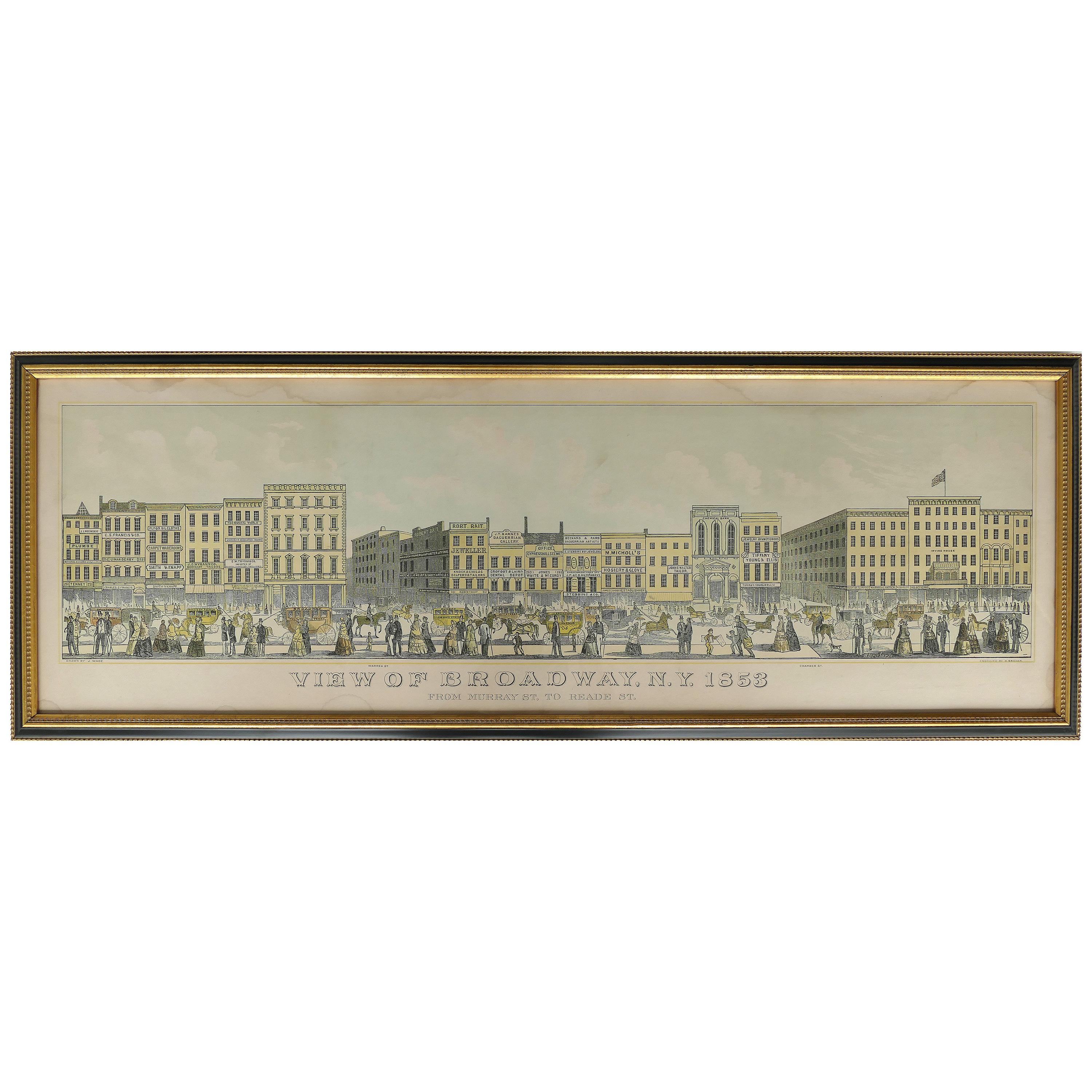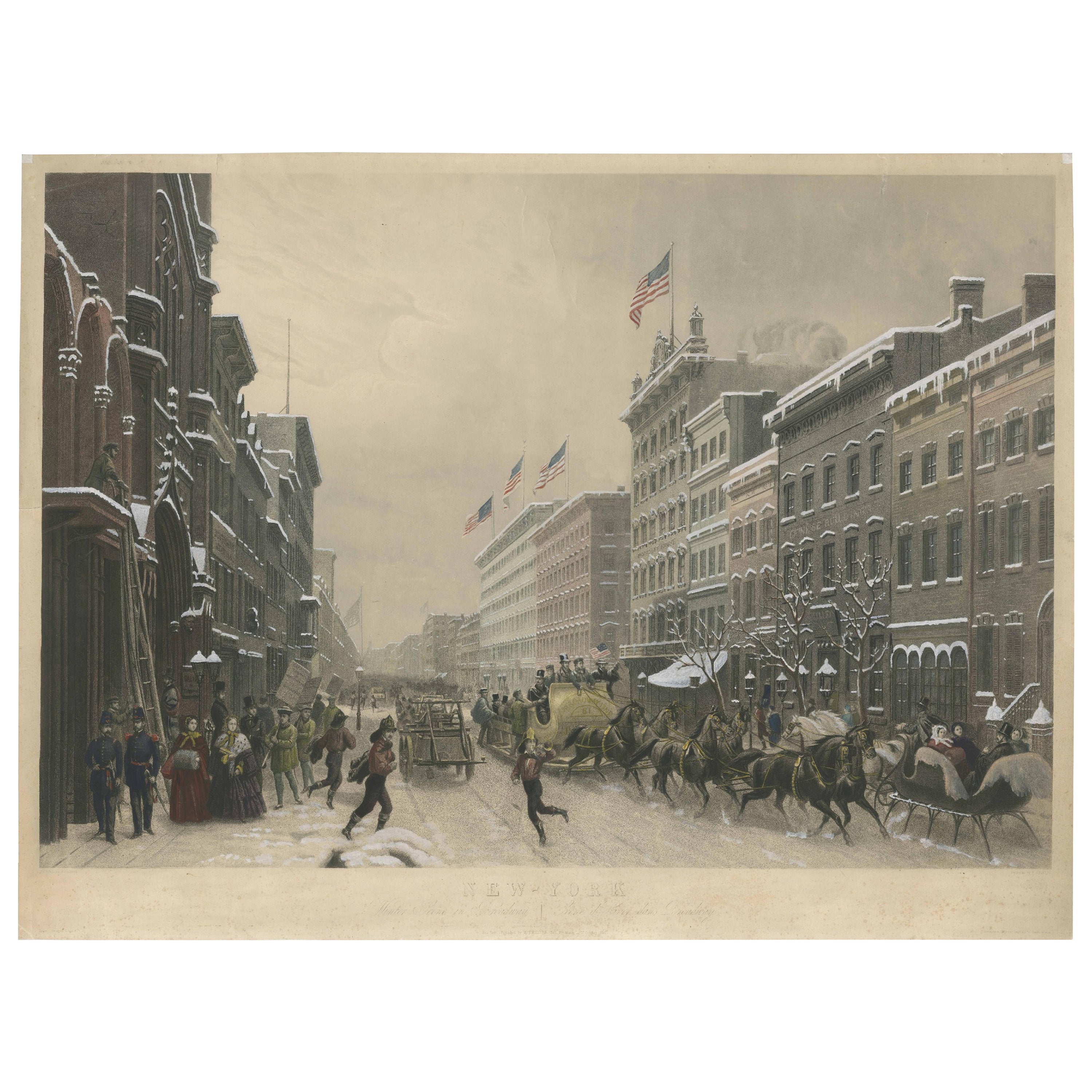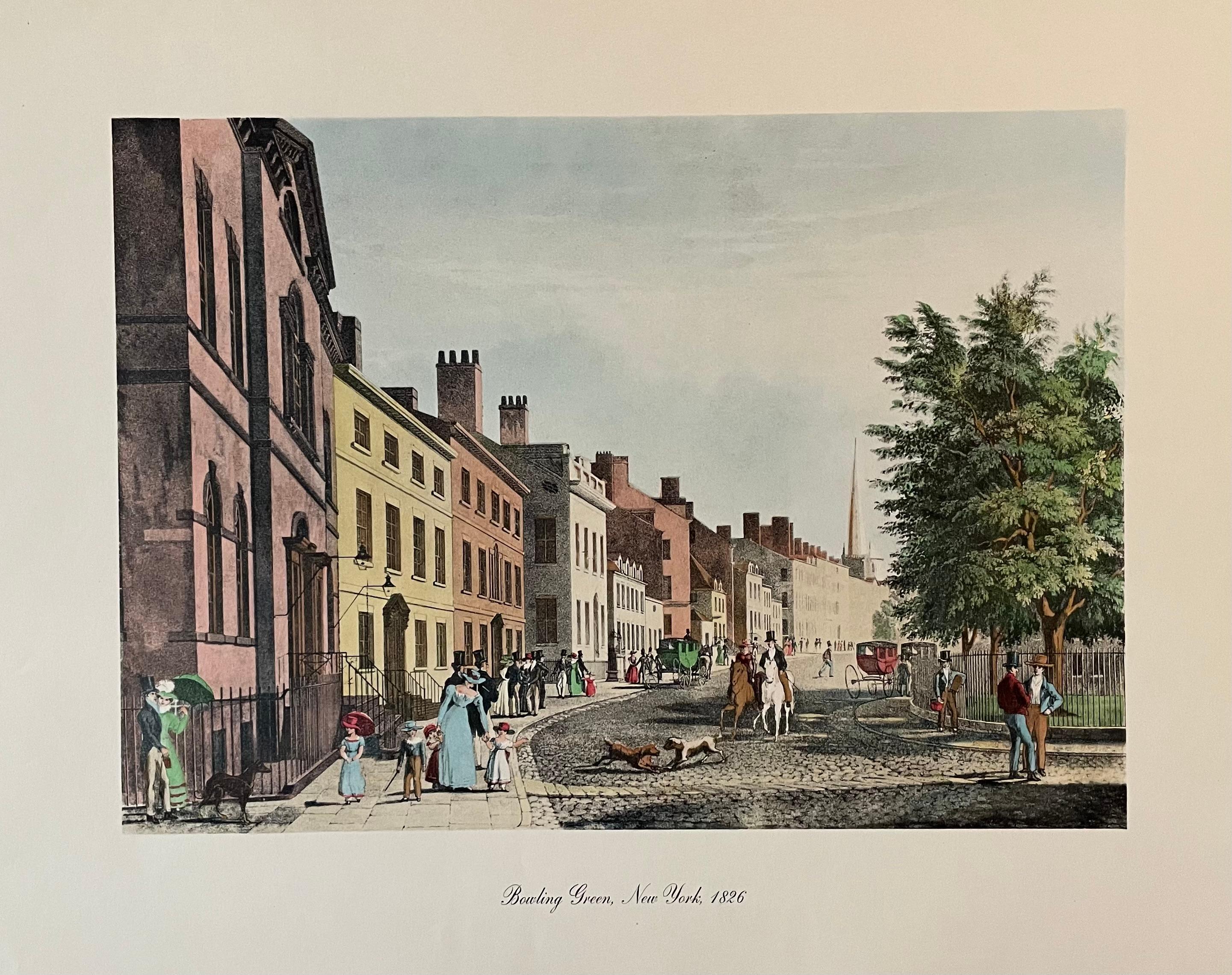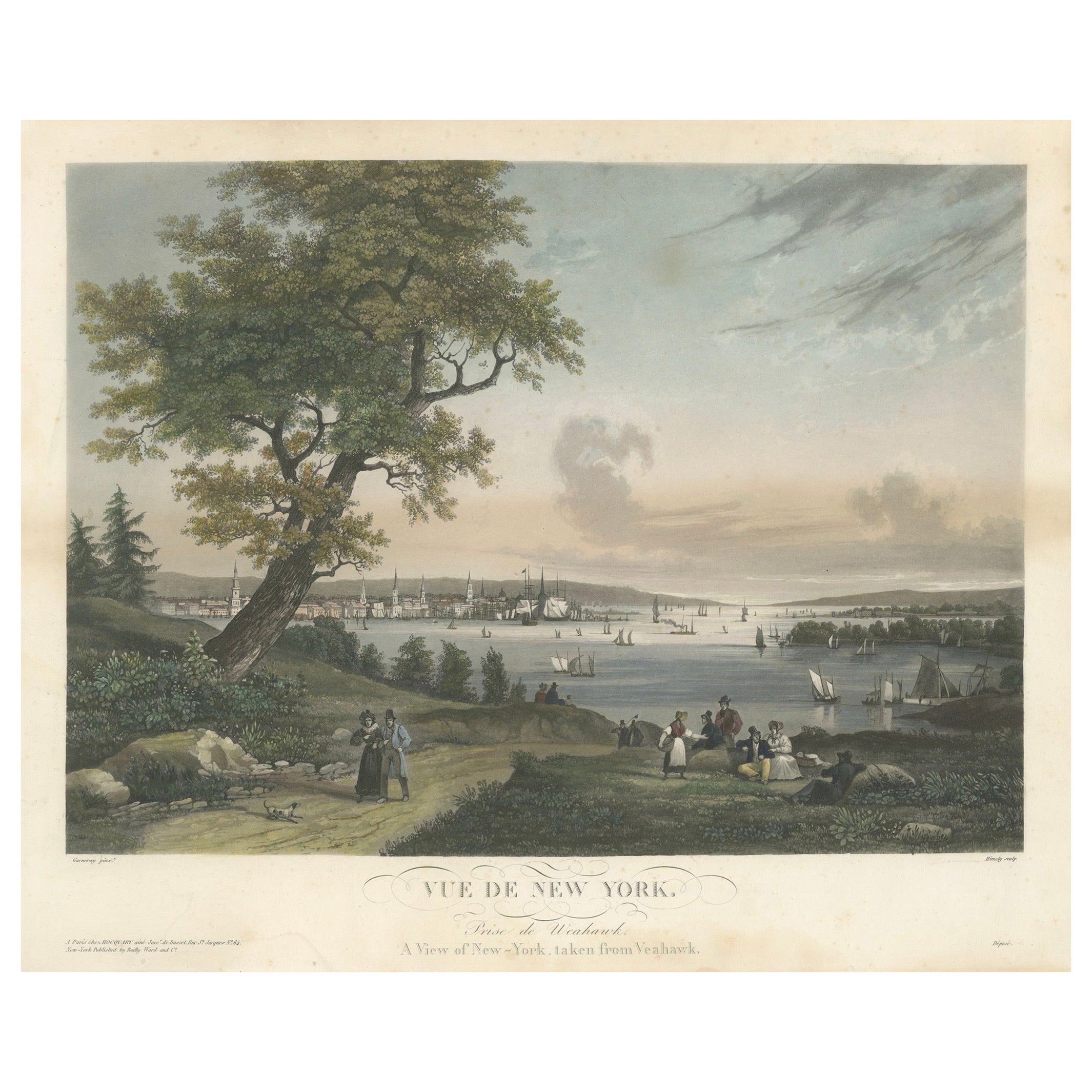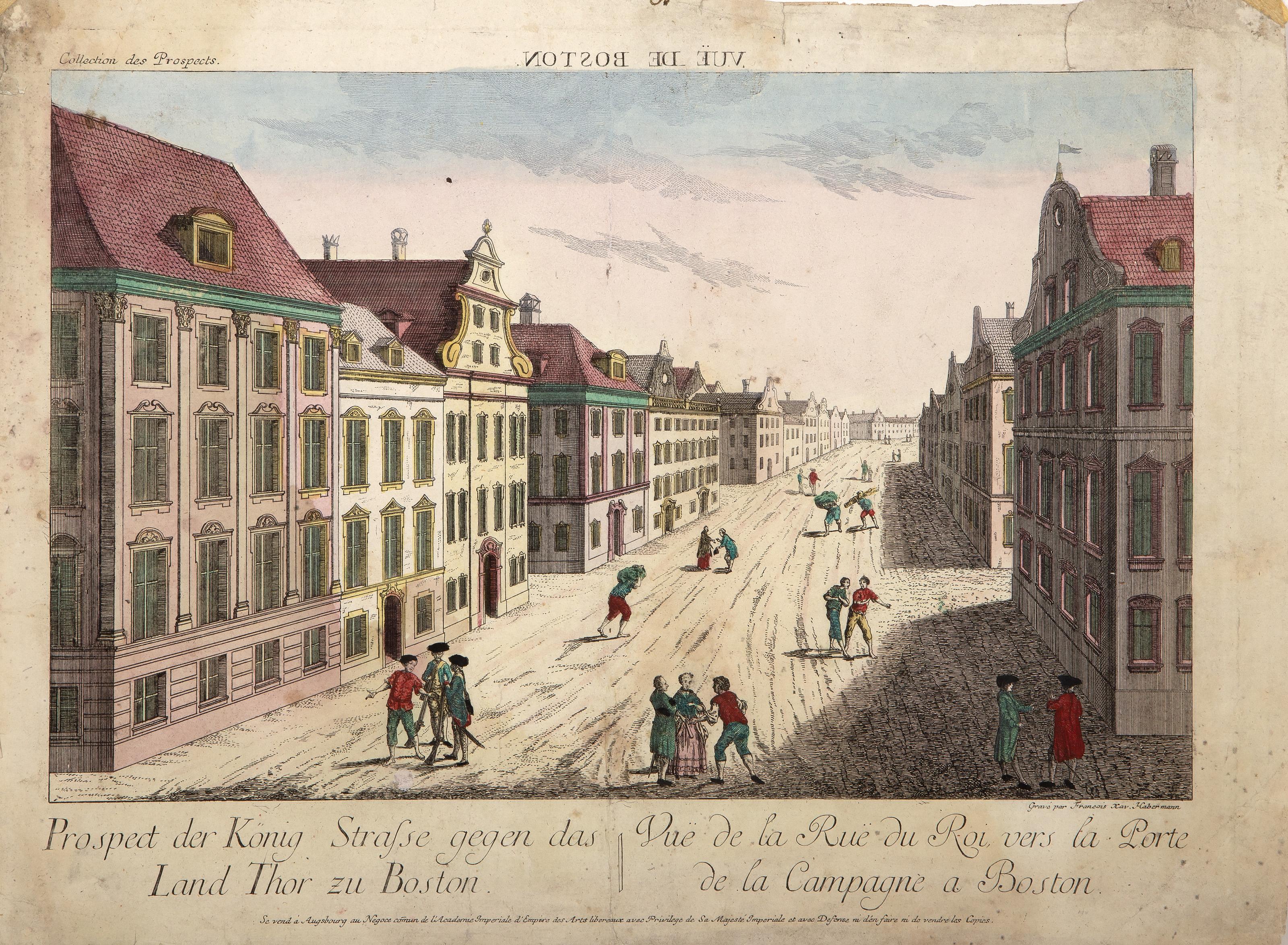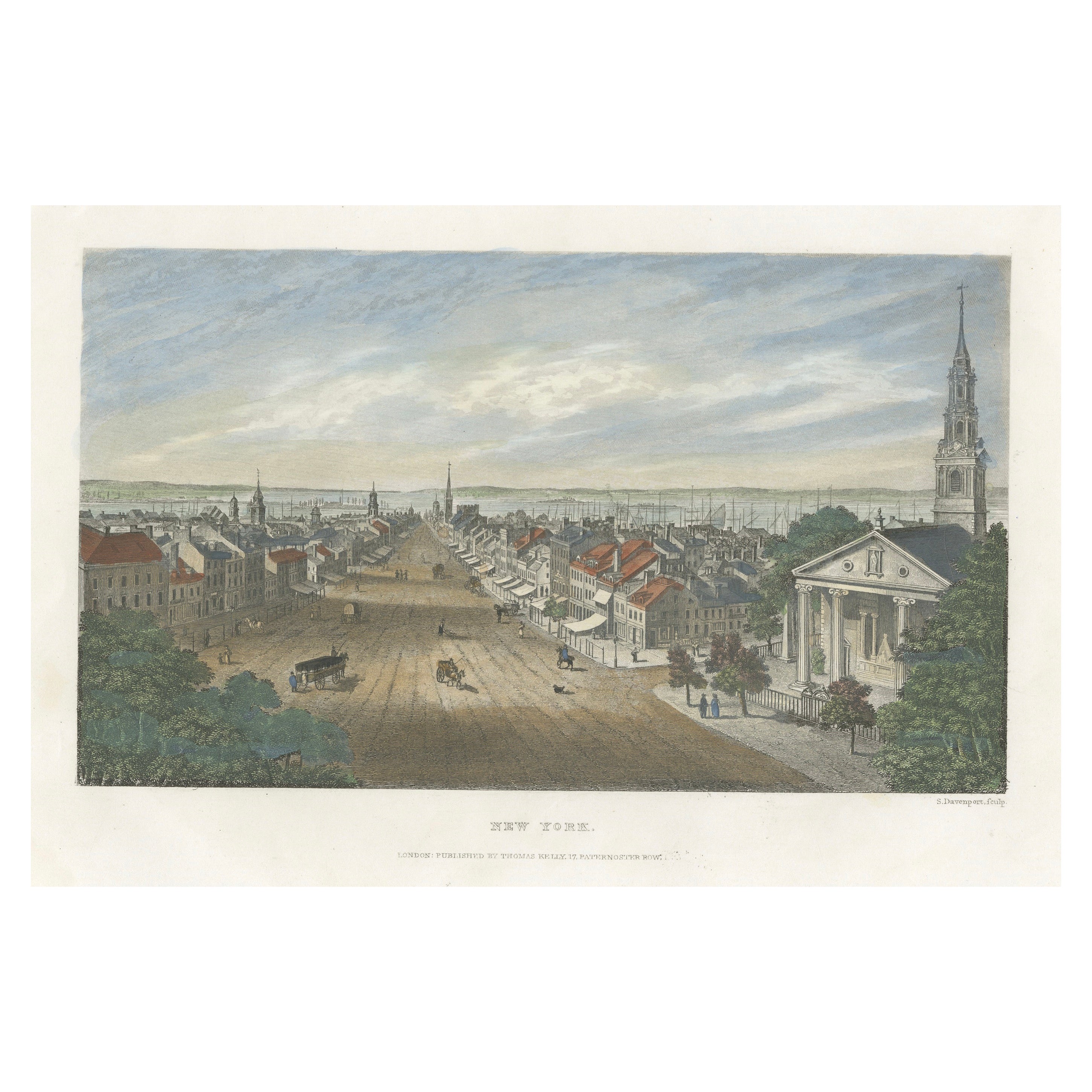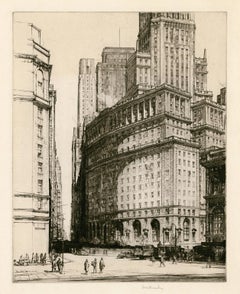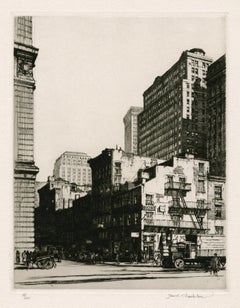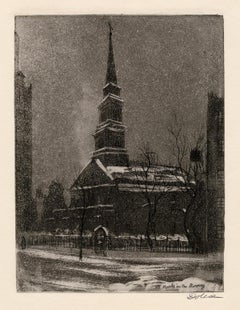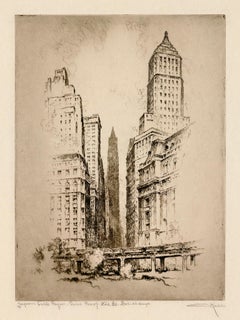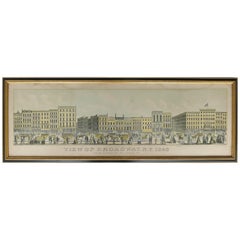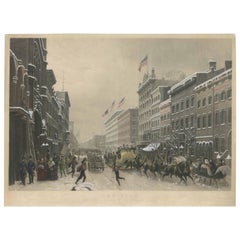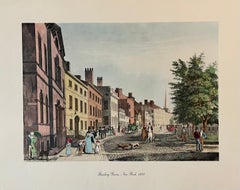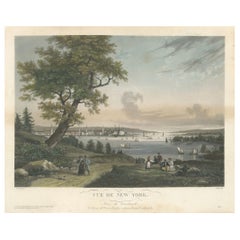Items Similar to Broadway from the Bowling Green, 1828 — early New York City, hand-coloring
Want more images or videos?
Request additional images or videos from the seller
1 of 6
J. R. HutchinsonBroadway from the Bowling Green, 1828 — early New York City, hand-coloring1828
1828
$1,200
£905.61
€1,036.78
CA$1,692.40
A$1,858.04
CHF 969.34
MX$22,484.89
NOK 12,149.23
SEK 11,447.77
DKK 7,739.31
About the Item
J. R. Hutchinson, 'Broadway from the Bowling Green, 1828', hand-colored etching, 1828. Signed and dated in the plate, beneath the image, lower right. Annotated 'Painted by J. Bennett', lower left and 'Published by R. Powell @ Grove Road, Briston, London, S. W.' in the upper right, above the image. A fine impression, with hand-coloring in watercolor; the full sheet with margins (2 1/4 to 2 5/8 inches), in very good condition. Image size 10 5/16 x 16 7/16 inches; sheet size 14 7/8 x 21 5/8 inches. Matted to museum standards, unframed.
An impression of this work is in the permanent collection of the New York Public Library.
About the Seller
5.0
Recognized Seller
These prestigious sellers are industry leaders and represent the highest echelon for item quality and design.
Platinum Seller
Premium sellers with a 4.7+ rating and 24-hour response times
Established in 1995
1stDibs seller since 2016
321 sales on 1stDibs
Typical response time: 1 hour
Associations
International Fine Print Dealers Association
- ShippingRetrieving quote...Shipping from: Myrtle Beach, SC
- Return Policy
Authenticity Guarantee
In the unlikely event there’s an issue with an item’s authenticity, contact us within 1 year for a full refund. DetailsMoney-Back Guarantee
If your item is not as described, is damaged in transit, or does not arrive, contact us within 7 days for a full refund. Details24-Hour Cancellation
You have a 24-hour grace period in which to reconsider your purchase, with no questions asked.Vetted Professional Sellers
Our world-class sellers must adhere to strict standards for service and quality, maintaining the integrity of our listings.Price-Match Guarantee
If you find that a seller listed the same item for a lower price elsewhere, we’ll match it.Trusted Global Delivery
Our best-in-class carrier network provides specialized shipping options worldwide, including custom delivery.More From This Seller
View AllBowling Green, New York
By Louis Conrad Rosenberg
Located in Myrtle Beach, SC
Louis Conrad Rosenberg, 'Bowling Green, New York', etching, 1940. Signed in pencil. A superb, richly-inked impression, with all the fine lines printing c...
Category
1940s American Realist Figurative Prints
Materials
Drypoint
'Manhattan Old and New' — Vintage New York Cityscape
By Samuel Chamberlain
Located in Myrtle Beach, SC
Samuel Chamberlain, 'Manhattan Old and New', drypoint, 1929, edition 100, Chamberlain and Kingsland 81. Signed, titled, and numbered '81/100' in pencil. Titled and annotated '30.00' in pencil, in the artist's hand, bottom margin. Matted to museum standards, unframed.
A superb, finely-detailed impression, with selectively wiped plate tone, on heavy Rives cream wove paper; full margins (1 1/2 to 2 1/4 inches), in excellent condition.
The subject of the print is the lower Manhattan cityscape just before the Depression.
Image size 8 3/4 x 6 13/16 inches (222 x 173 mm); sheet size 12 3/4 x 10 inches (324 x 254 mm).
Impressions of this work are held in the collections of the National Gallery of Art and the Zimmerli Art Museum.
ABOUT THE ARTIST
'There is something about the atmospheric vibrancy of an etching which imparts a peculiar and irresistible life to architectural drawing...A copper plate offers receptive ground to the meticulously detailed drawing which so often appeals to the architect'. —Samuel Chamberlain, from the Catalogue Raisonné of his prints.
Samuel V. Chamberlain (1896 - 1975), printmaker, photographer, author, and teacher, was born in Iowa. His family moved to Aberdeen, Washington in 1901, and in 1913, Chamberlain enrolled in the University of Washington in Seattle, where he studied architecture under Carl Gould. By 1915, he was enrolled in the School of Architecture of the Massachusetts Institute of Technology in Boston. With the United States' involvement in the First World War, Chamberlain sailed to France, where he volunteered in the American Field Service. In 1918, he was transferred to the United States Army to complete his tour of duty. After the war, he returned to Boston and resumed his architectural studies, which he eventually discontinued, working for a few years as a commercial artist.
Chamberlain received the American Field Service Scholarship in 1923, which he used to travel to Spain, North Africa, and Italy. In 1924 he was living in Paris, where he studied lithography with Gaston Dorfinant and etching and drypoint with Edouard Léon, publishing his first etching the following year. In 1927, he studied drypoint with Malcolm Osborne...
Category
1920s American Modern Landscape Prints
Materials
Drypoint
'St. Marks on the Bowery' - Famed New York City Landmark
By Leon Dolice
Located in Myrtle Beach, SC
'St. Mark's Church on the Bowery', aquatint with etching, edition not stated but small, 1932. Signed in pencil. Signed in the plate lower left and titled in the plate lower right. A superb, atmospheric impression, on cream wove paper, with full margins (1 1/8 to 2 inches), in excellent condition. Matted to museum standards, unframed.
Image size 9 3/4 x 7 3/8 inches (248 x 187 mm); sheet size 13 1/8 x 10 inches (333 x 254 mm).
Impressions of this work are held in the collections of the Princeton University Art Museum and the Five College Museums.
ABOUT THE ARTIST
Born in Vienna, Leon Dolice left a secure position in the family business to pursue his artistic interests. He began his art education in his teens and early twenties when he traveled through Europe to study the works of the Old Masters. He immigrated to America in 1920 and made his home in Manhattan. As a printmaker, he chose as his subjects the architecture, back streets, dock scenes, and other aspects of New York City life that were being overtaken by the modern world.
In 1950, learning of the coming demolition of the Third Avenue El, Dolice created a series of Third Avenue and other New York City landmarks that were threatened with extinction. His images from that period provide a record of a New York that has passed into history.
During his lifetime, Dolice exhibited throughout Europe and the United States. Retrospectives of his work include a one-man show of his graphic work at Tribeca Gallery, New York; the traveling exhibition ‘Vintage New York’ with the New Rochelle Council on the Arts; and the Hofstra Museum, Hempstead.
Dolice's works are in the permanent collections of the Museum of the City of New York, the National Gallery of Art, the New York Historical Society, Georgetown University, the Philadelphia Print Club, and the New York Public Library, as well as private and corporate collections.
ABOUT ST. MARKS CHURCH
St. Mark's Church in-the-Bowery is a parish of the Episcopal Church located at 131 East 10th Street, at the intersection of Stuyvesant Street and Second Avenue in the East Village neighborhood of Manhattan in New York City. The property has been the site of continuous Christian worship since the mid-17th century, making it New York City's oldest site of continuous religious practice. The structure is the second-oldest church building in Manhattan.
In 1651, Petrus Stuyvesant, Director General of New Netherland, purchased land for a bowery or farm from the Dutch West India Company and, by 1660, built a family chapel at the present-day site of St. Mark's Church. Stuyvesant died in 1672 and was interred in a vault under the chapel.
Stuyvesant's great-grandson, Petrus "Peter" Stuyvesant, sold the chapel property to the Episcopal Church for $1 in 1793, stipulating that a new chapel be erected to serve Bowery Village, the community which had coalesced around the Stuyvesant family chapel. In 1795, the cornerstone of the present-day St. Mark's Church was laid, and the fieldstone Georgian-style church, built by the architect and mason John McComb Jr., was completed and consecrated on May 9, 1799.[4] Alexander Hamilton provided legal aid in incorporating St. Mark's Church as the first Episcopal parish independent of Trinity Church in New York City. By 1807, the church had as many as two hundred worshipers at its summer services, with 70 during the winter.
While the 19th century saw St. Mark's Church grow through its many construction projects, the 20th century was marked by community service and cultural expansion. Today, the rectory houses the Neighborhood Preservation Center, the Greenwich Village Society for Historic Preservation, and the Historic Districts Council, as well as other preservation and community organizations such as the Poetry Project, the Millennium Film Workshop, and the Danspace Project.
St Mark's has supported an active artistic community since the 19th century. In 1919, poet Kahlil Gibran was appointed a member of the St. Mark's Arts Committee, and the next year, the two prominent Indian statues, "Aspiration" and "Inspiration" by sculptor Solon Borglum...
Category
1930s American Modern Landscape Prints
Materials
Etching, Aquatint
'The Gateway to the New World' — Vintage New York City
By Otto Kuhler
Located in Myrtle Beach, SC
Otto Kuhler, 'The Gateway to the New World', etching (artist's proof), edition 16, 1926, Kennedy 25. Signed in pencil and annotated 'Japan Silk Paper - Trial Proof - Ltd. Ed. Del. et...
Category
1920s American Modern Figurative Prints
Materials
Etching
'Downtown, New York' — 1920s Modernism
By John Taylor Arms
Located in Myrtle Beach, SC
John Taylor Arms, 'Downtown, New York', etching with aquatint, 1921, edition 75, Fletcher 108. Signed, dated, and numbered 14/75 in pencil.
A superb, finely nuanced impression, in d...
Category
Early 20th Century American Modern Landscape Prints
Materials
Etching
'The Elevated, East 42nd Street, New York' — 1910 American Realism
By William Monk
Located in Myrtle Beach, SC
William Monk, 'The Elevated, East 42nd Street, New York', etching, 1910. Signed in pencil and titled in the bottom right sheet corner. Signed in the plate, lower right. A superb, ric...
Category
1910s American Realist Figurative Prints
Materials
Etching
$1,200 Sale Price
20% Off
You May Also Like
"View of Broadway, N.Y. 1853" Engraving by J. Wade and H. Bricher
Located in Miami, FL
"View of Broadway, N.Y. 1853" Engraving by J. Wade and H. Bricher
Offered for sale is an engraving drawn by J. Wade and engraved by H. Bricher titled "View of Broadway, N.Y. 1853 f...
Category
Antique Mid-19th Century American Prints
Materials
Glass, Wood, Paper
$350 Sale Price
26% Off
Stunning Winter Scene on Broadway, New York - Hand-Colored Aquatint from 1857
Located in Langweer, NL
Title: Stunning Winter Scene on Broadway, New York - Hand-Colored Aquatint from 1857
Description:
This aquatint engraving with hand-coloring, created by Paul Girardet after Hip...
Category
Antique 1850s Prints
Materials
Paper
Bennett: Bowling Green, New York, 1826
Located in Chesterfield, MI
Historical Print entitled "Bennett: Bowling Green, New York" 1826 as noted in bottom Left Corner
It was published by Rudolf Leach Fine Arts, Inc.,
225 Fifth Avenue, New York City
...
Category
1820s Realist Landscape Prints
Materials
Lithograph
$120 Sale Price
20% Off
View of New York City from Weehawken, Rare Hand-Colored 1834 Aquatint Print
Located in Langweer, NL
Title: View of New York City from Weehawken, Rare Hand-Colored 1834 Aquatint Print
Description: This exquisite hand-colored aquatint and engraving, titled "Vue de New York: Prise de...
Category
Antique 1830s Prints
Materials
Paper
Vue de Boston, American Realist Hand colored engraving by Franz Xavier Habermann
Located in Long Island City, NY
Franz Xavier Habermann, German (1721 - 1796) - Vue de Boston, Year: circa 1750, Medium: Hand colored engraving on laid paper, Image Size: 9.75 x 15.5 inches, Size: 13 x 17.5 in. (3...
Category
1750s American Realist Landscape Prints
Materials
Engraving
A Glimpse into the Early 19th Century Urban Landscape of New York, a 1842 Print
Located in Langweer, NL
The hand-colored print titled "New York," published in 1842, presents a detailed and picturesque view of the cityscape of New York as it appeared in the early 19th century. The title "New York" is centered below the image. Below the title, the text reads "LONDON: Published by Thomas Kelly. 17, Paternoster Row," indicating the publisher and location of publication in London. Additionally, the text "S. Davenport. Sculp." is printed beneath the image, signifying that the engraving was done by S. Davenport.
Description of the Image:
- **Perspective**: The image provides a broad view, likely from an elevated point, showing the expanse of the city. The perspective gives a sense of depth, with the street extending into the distance.
- **Central Street**: A wide, unpaved street runs down the center of the image, flanked by rows of buildings on both sides. This street is bustling with various activities.
- **Buildings**: The buildings are primarily two to three stories tall, featuring a mix of architectural styles typical of the period. Some have distinct red roofs, adding a touch of color to the scene.
- **Churches**: There are several prominent churches with tall spires visible in the background, indicating the importance of religious institutions during that time.
- **Foreground**: In the foreground, to the right, there is a large, columned building, which might be a significant public or religious structure.
- **Activity**: The street scene includes horse-drawn carriages and pedestrians, capturing the everyday life of the city's inhabitants.
- **Harbor**: In the far background, you can see masts of ships, indicating the proximity of the harbor and the importance of maritime activities to the city.
Artistic and Historical Context:
- **Engraving Style**: The work of S. Davenport, an engraver, suggests fine detail and precision typical of hand-colored prints of that era.
- **Historical Significance**: This print serves as a valuable historical document, offering a glimpse into the urban layout and architecture of New York City in the early 1840s.
- **Publishing Context**: Being published in London by Thomas Kelly indicates a transatlantic interest in the growing metropolis of New York, reflecting its emerging significance on the global stage.
This print is not only an artistic representation but also a historical record, encapsulating the essence of New York City during a period of significant growth and development.
Identifying specific buildings from a historical print like this one can be challenging, especially without modern landmarks for direct comparison. However, a few notable buildings and features from New York in the early 1840s could potentially be recognized based on historical context and architectural details.
Potential Recognizable Buildings:
1. **St. Paul's Chapel**: Given its prominent spire and proximity to the center of early New York...
Category
Antique 1840s Prints
Materials
Paper
$317 Sale Price
20% Off
More Ways To Browse
Powell Antique
Broadway Green
Salvador Dali Paradise 6
Salvador Dali Paradise Lost
Salvador Dali Purgatory 1
Salvador Dali Self Portrait
Salvador Dali Signature
Salvador Dali Signed Paradise
Salvador Dali Signed Purgatory Canto
Salvador Dali Tapestry
Salvador Dali The Doctor
Salvador Dali The Kiss
Salvador Dali The Lovers
Salvador Dali The Ship Of Souls
Salvador Dali Tree Of Knowledge
Sarah Slappey
Shag Josh Agle
Shepard Fairey Guns
